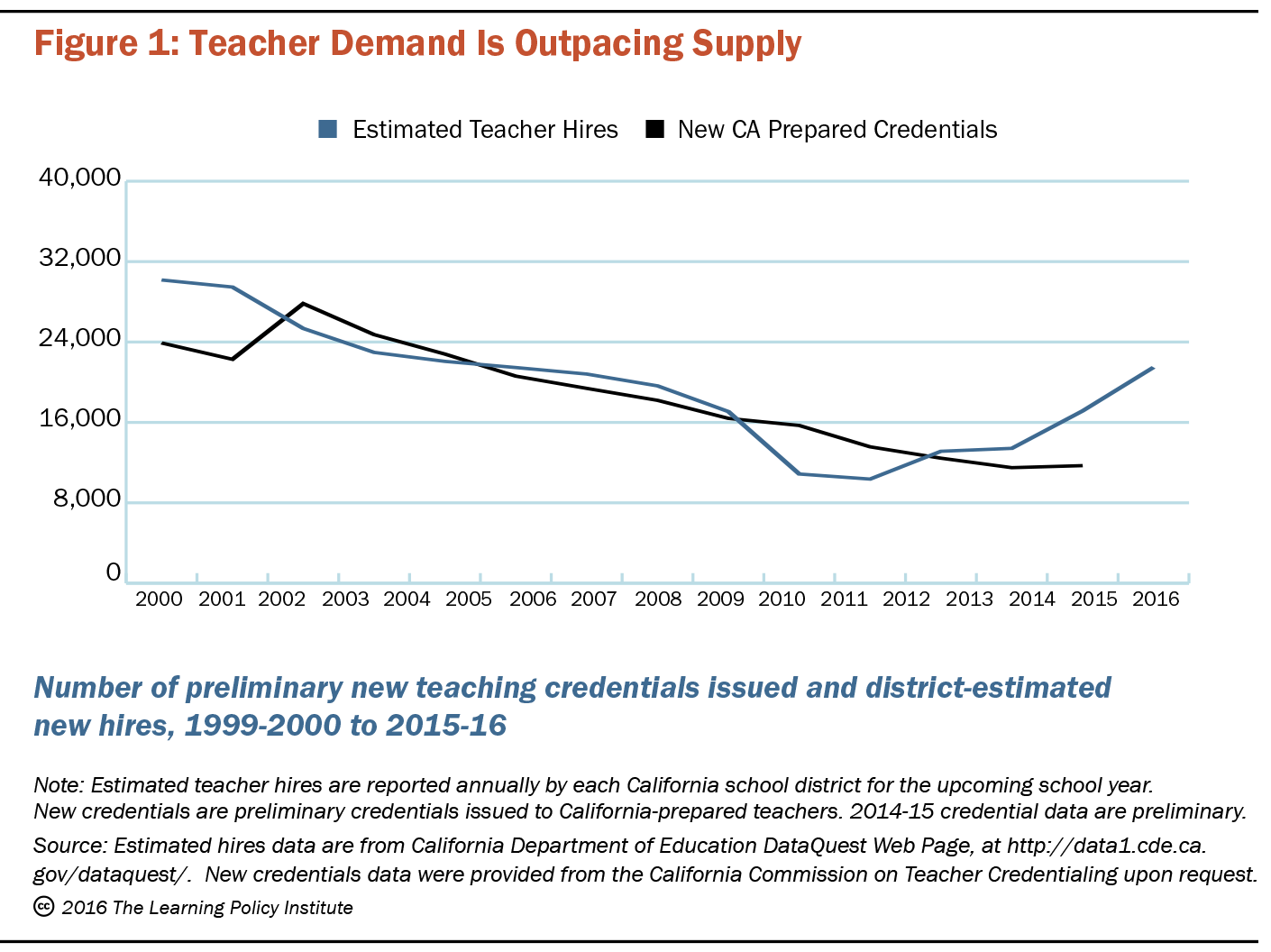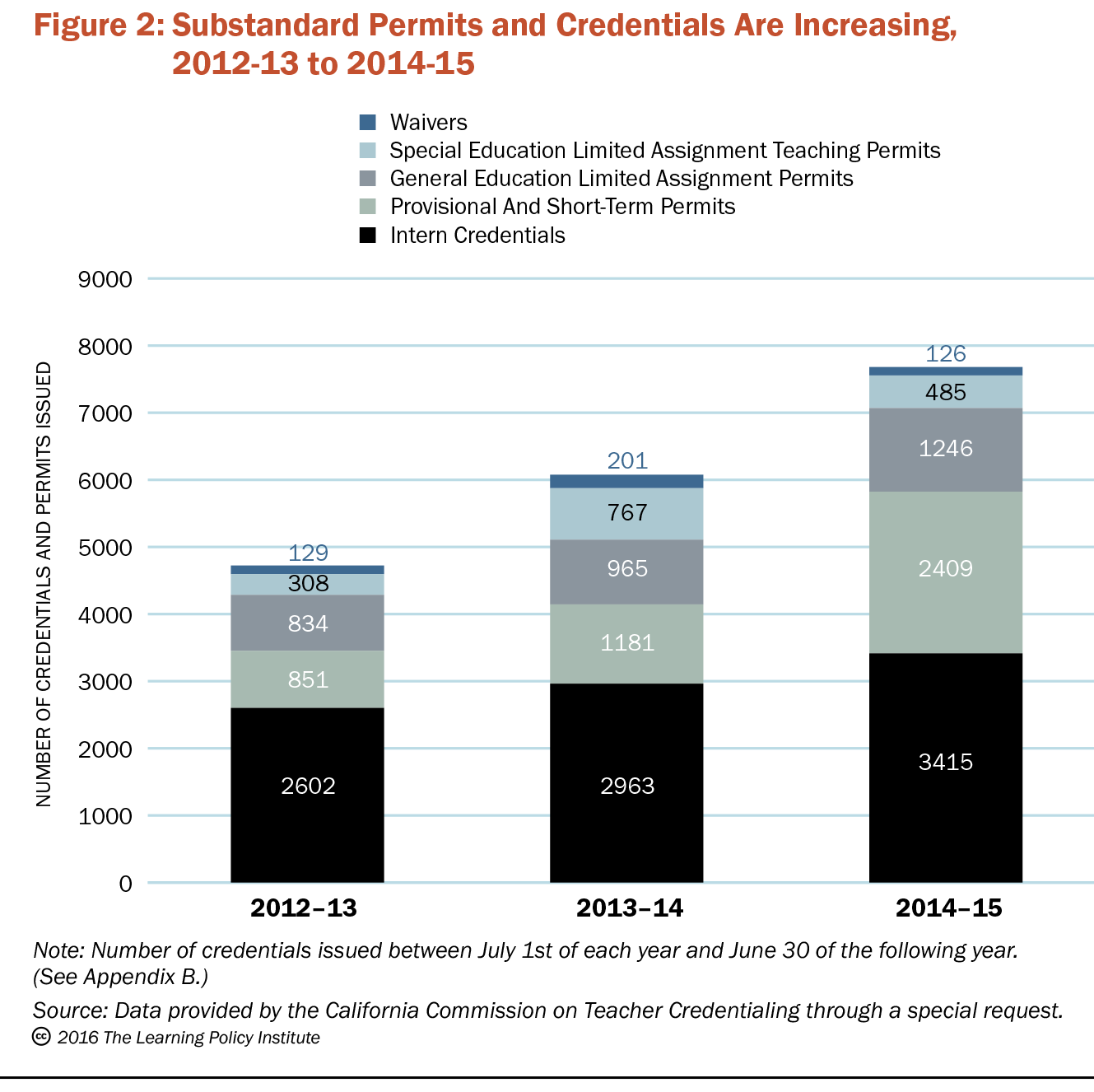Addressing California’s Emerging Teacher Shortage

Summary
After many years of teacher layoffs, a change is underway in California: With new money in the system, districts are hiring again, and they cannot find enough qualified teachers to fill their vacancies. Shortages in many fields and locations across the state have been provoked by a steep decline in candidates preparing to teach, coupled with an increase in demand fueled largely by teacher attrition and schools’ reinstatement of previously cut staff positions. This has triggered a rapid increase in the issuance of permits and credentials for underprepared teachers. A majority of voters polled are concerned about the shortage and support actions to mitigate its impact. This analysis shows the genesis of the current shortages, evaluates the factors that will determine future trends, and makes recommendations for addressing these problems.
Throughout California, school districts are grappling with teacher shortages. Credentials issued to new teachers are at an historic low at the very time districts have increased their hiring to expand programs and restore teaching positions eliminated during the Recession. This brief summarizes a Learning Policy Institute report that examines indicators of the current shortages, discusses their impact on students, and analyzes factors influencing teacher supply and demand in California and nationally. It concludes with policy recommendations to ensure an adequate supply of fully prepared teachers for the fields and locations where they are needed.
Findings
Increased demand for K–12 teachers in California comes at a time when the supply of new teachers is at a 12-year low. Enrollment in educator preparation programs has dropped by more than 70 percent over the last decade, and has fallen below the number of estimated hires by school districts around the state. Many signs point to shortages:
- In mid-October, two months after the school year started, EdJoin, the statewide educator job portal, still listed more than 3,900 open teaching positions—double the number listed at that time in 2013.
- Estimated teacher hires for the 2015–16 school year increased by 25 percent from 2014-15, while preliminary credentials issued to fully prepared new teachers increased by less than 1 percent in the previous year, and enrollment in UC and CSU teacher preparation programs increased by only about 3.8 percent. (See Figure 1.)
- In 2014–15, provisional and short-term permits (issued to fill “immediate and acute” staffing needs when a fully credentialed teacher can’t be found) nearly tripled from the number issued two years earlier, growing from about 850 to more than 2,400.
(See Figure 2.) - In all, the number of teachers hired on substandard permits and credentials nearly doubled in the last two years, to more than 7,700, comprising a third of all the new credentials issued in 2014–15.

Although shortages are occurring across a range of subject areas, the problem is most acute in mathematics, science, and special education. Each of these fields is marked by a drop in the number of preliminary credentials issued to new teachers and a significant increase in the number of temporary permits, waivers, and intern credentials:
- In mathematics and science, the number of preliminary credentials awarded to new, fully prepared teachers dropped by 32 percent and 14 percent, respectively, over the last four years.
- In that same time, the numbers of underprepared mathematics and science teachers (those with temporary permits and waivers and intern credentials) increased by 23 percent and 51 percent, respectively.
- In special education, the number of credentials issued dropped by 21 percent between 2011–12 and 2013–14, while substandard permits and credentials increased by 10 percent. Nearly half (48 percent) of special education teachers licensed in California in 2013–14 lacked full preparation for teaching.
- There’s a large and growing disparity between supply and demand for special education teachers. For example, while districts estimated their hiring needs at roughly 4,500 special education teachers in 2014–15, only about 2,200 fully prepared new teachers emerged from California’s universities that year.

As in previous times when California experienced a shortage of qualified teachers, low-income students of color and students with special needs are disproportionately impacted. According to California’s educator equity plan, in 2013–14, twice as many students in high-minority as in low-minority schools were being taught by a teacher on a waiver or permit (a teacher not yet even enrolled in a preparation program). Similar disparities existed between students in high- and low-poverty schools. In the 2000–01 school year, during the last round of acute shortages, 40,000 California teachers were working on emergency credentials, the vast majority of them in high-minority and high-poverty schools. At that time, one in four students in these schools was taught by an underprepared teacher in any given year, placing at greater risk the quality of education these students received.
Prognosis for the Future
What’s driving the increased demand? The most significant factor is the desire by districts to leverage increased school funding to return student-teacher ratios to pre-Recession levels. California has the highest student-teacher ratio in the nation. The disparity became even more pronounced during the extended years of budget cuts. By 2013, the state’s student-teacher ratio had reached 24 to 1, compared to the national average of 16 to 1. For California to bring student-teacher ratios back to pre-Recession levels, districts would need to hire 60,000 new teachers beyond their other hiring needs. If California were to reduce student-teacher ratios to the national average, districts would have to hire 135,000 additional teachers.
Although enrollments are expected to be largely stable statewide, in some counties enrollment growth will play a critical role in determining hiring needs. In 11 counties, enrollments are expected to grow by more than 5 percent in the coming decade; in Kern and Imperial counties, enrollments are expected to grow by more than 10 percent.
Attrition from retirement will also vary by district and county. With 34 percent of teachers statewide age 50 and older, and nearly 10 percent age 60 and older, retirements will continue to be a factor in many locations over the next five to 10 years.
Non-retirement attrition, ranging from medical leave and family moves to departures for other districts, states, or out of the profession entirely, is an even larger factor—typically accounting for two-thirds of teachers who leave. Research shows that salary levels and other aspects of compensation matter (such as college debt levels and housing costs), as do working conditions, especially having a supportive administrator and a collegial work environment. Turnover for beginners—who leave at much higher rates than other teachers—is influenced by how well novices are prepared prior to entry and how well they are mentored in their first years on the job.
Teacher turnover not only increases demand, it exacts a cost on districts and the students they serve. Replacement costs for teachers have been found to be about $18,000 per teacher who leaves, which adds up to a national price tag of more than $7 billion a year. High turnover also negatively affects the achievement of all students in a school.
On the supply side, the overall desirability of teaching as a profession is the most important factor affecting whether young people or career switchers decide to become teachers. Other factors include include ease of entry, competitiveness of salaries, and teaching conditions. The highly publicized teacher layoffs during the budget downturn left a mark on the public psyche, including individuals who might have been considering a teaching career. At the same time, salaries were frozen and teaching conditions deteriorated considerably as resource limitations led to increased class sizes and fewer materials and instructional supports. One sign of the cumulative impact of these factors is that only 5 percent of the students in a recent survey of college-bound students were interested in pursuing a career in education, a decrease of 16 percent between 2010 and 2014.
California is on a trajectory that, if left unchecked, could result in increased teacher shortages and greater inequities among students in different communities. Earlier state policy initiatives were greatly reduced or terminated during the last era of state budget cuts. Reinstating incentives for teacher recruitment and retention will be a critical component of a thoughtful strategy to address the emerging teacher shortage.
Policy Recommendations
Based upon this analysis and prior research, the authors offer the following policy recommendations for consideration:
- Reinstate the CalTeach program, which helped recruit teachers from colleges, other careers, and other states; provided them information about how to become credentialed; and directed them to preparation programs and districts so that entry into the profession was made simpler and more supported.
- Create incentives to attract diverse, talented individuals to teach in high-need locations and fields by funding candidates who prepare and teach in such schools and subject areas, as did two highly successful California programs: the Governor’s Teaching Fellowship and the Assumption Program of Loans for Education (APLE).
- Create innovative pipelines into teaching, such as high school career pathways and Grow-Your-Own teacher preparation models, which encourage and support young people and others to go into teaching in their own communities. These strategies are aligned with the research findings that many young people can be attracted to teaching early in life, and teachers prefer to teach near where they grew up and attended high school.
- Increase access to high-quality preparation programs that support teacher success in high-need districts and fields. California needs new approaches to training and recruitment to solve shortages in communities and fields that have longstanding challenges In particular, innovative programs like teacher residencies are needed for training urban and rural teachers. New model programs that begin in the undergraduate years are also needed for preparing special educators.
- Ensure that all beginning teachers have access to a high-quality support and mentoring program that can reduce early attrition and enhance competence, such as is available through well-designed Beginning Teacher Support and Assessment (BTSA) programs.
- Provide incentives that support teachers’ ability to stay in or re-enter the profession through strategies like mortgage guarantees for housing, ease of credential renewal, streamlined reciprocity with other states, and opportunities to continue teaching and mentoring after retirement.
- Improve teaching conditions by supporting administrator training that enables principals to create productive teaching and learning environments.
Addressing California’s Emerging Teacher Shortage: An Analysis of Sources and Solutions (research brief) by Linda Darlng-Hammond, Roberta Furger, Patrick M. Shields, and Leib Sutcher is licensed under a Creative Commons Attribution-NonCommercial 4.0 International License.
Research in this area of work is funded in part by the S. D. Bechtel, Jr. Foundation. Core operating support for the Learning Policy Institute is provided by the Ford Foundation, the William and Flora Hewlett Foundation, and the Sandler Foundation.
